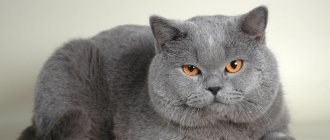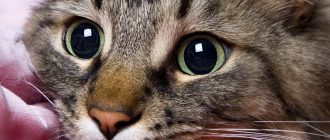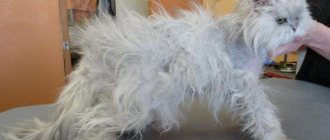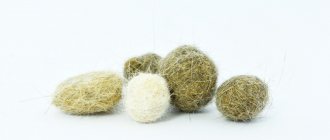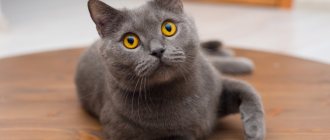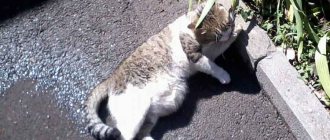Signs of peeling
Peeling is the formation of an excessive amount of dead epithelium on the surface of the skin. There are 2 mechanisms involved in the peeling process:
- excessive keratinization;
- excessive rejection of epithelial tissue.
Peeling can occur against the background of thinning or thickening of the skin. Quite often, the process is accompanied by itching, which causes the cat to itch and put its skin in an even worse condition. Scratching, when pathogenic bacteria enter the wounds, can cause bacterial inflammation of the skin.
Peeling occurs due to necrosis of the stratum corneum of the skin, which is unusual for the cat’s body. Necrosis is caused by unfavorable environmental factors or internal pathologies.
Baldness due to pancreatitis
It is difficult to imagine that a cat could develop bald patches due to chronic pancreatitis. This disease, even with a sluggish course, is accompanied by diarrhea, indigestion, fatigue and lethargy of the animal. Also, with this disease, the cat becomes bald on the back and other parts of the body.
ATTENTION!
The presence of pancreatitis in an animal, due to which its fur on its tail, back, and between its hind legs is thinning, can be determined not only by frequent diarrhea, but also by rumbling in the stomach.
External causes of violation
These factors cause skin irritation and peeling upon direct contact with it. Usually it is enough to eliminate this factor and the skin will return to normal.
Physical factors
Excessive sunlight, high and low temperatures, and insufficient air humidity in the room where the animal is kept can lead to excessive keratinization of the epidermis and active desquamation of the top layer of skin.
Chemical reasons
These are aggressive substances: acids, alkalis and other reagents that have an aggressive effect on the animal’s skin. Such substances can cause not only peeling, but also dermatitis, eczema and atopy.
This group includes not only acids or alkalis, but also shampoos or other skin and hair care products that can irritate the epidermal layer. Quite often, peeling begins as a result of excessive care of the animal’s skin using cosmetics.
Infectious and parasitic factors
This group includes a large number of parasitic infections, which are not so rare. The top three similar causes of the deplorable condition of an animal’s skin are: the consequences of flea dermatitis, lice and demodicosis (infection with small skin mites). In addition to peeling, these pathologies are accompanied by severe itching, loss of animal hair, rashes (bubbles, crusts), and scratching. Parasite eggs and their metabolic products are found in the animal’s fur.
Worm infestations cause skin itching, flaking and deterioration in coat quality. This happens because parasites disrupt the digestive processes, mechanically interfering with the movement of food through the digestive system. And they also absorb nutrients, leading to vitamin deficiencies. The presence of worms in a cat’s body leads to dyspepsia, and sometimes vomiting and diarrhea.
Fungal infections (including ringworm, malassezia) are necessarily accompanied by peeling. Although the first symptom that the owner pays attention to in this case is baldness. The first lesions are usually found on the head and face of the animal. With Malassezia, greasy ears and skin pigmentation are noticeable.
Mechanical factors
Mechanical causes of peeling include abrasions, scratches, and traces of friction. Sometimes the skin peels off at the injection sites. In this case, alopecia areata is usually observed. A crust forms at the site of the injured skin, and the epidermis becomes rough. The skin around the site of injury begins to peel off.
Fighting baldness in cats
Cat owners, having noticed changes in the animal’s hair, begin to panic and look for an answer to the question of what to do if the cat’s hair falls out. Different causes of hair loss require different treatment approaches.
The longest and most difficult treatment is when hair falls out from skin mites and fungal diseases, which require the use of toxic drugs strictly according to the regimen prescribed by the doctor. At the same time, a thorough disinfection of the room will be required, including treatment of all carpeting and furniture, as well as disinfection or replacement of the cat’s bedding.
The result of an unbalanced diet, accompanied by signs of partial baldness, for example, when a cat has flaking hair on its hind legs, is treated mainly with diet. Pets on dry food should receive enriched vitamin complexes, and those on a natural diet should receive low-fat foods with the addition of B vitamins. To relieve itching, antihistamines can be given in small doses no more than twice a day.
Cat owners know that from time to time they have to collect cat hair around the house, as the period of natural hair loss begins. But why do some cats have too much fluffy cover, and even bald patches form near the tail or on the tummy and paws?
Severe hair loss is not normal
, you should definitely pay attention to it and seek advice from a specialist. But don’t be alarmed right away; perhaps the animal is lacking vitamins or this is how a skin disease manifests itself.
The veterinarian will diagnose why the cat’s hair is falling out and bald spots are forming, prescribe treatment, and explain preventive measures. If your cat sheds hair but immediately grows new hairs, it’s just shedding season.
.
Internal reasons
The top three reasons leading to deterioration of the skin condition include dietary errors, diseases of the digestive system and psychogenic peeling.
Errors in the animal’s nutrition lead to vitamin deficiencies/hypovitaminosis or allergies.
In addition to these reasons, peeling can develop as a result of endocrinopathies, immunodeficiency, autoimmune processes, diseases of the blood system and sebaceous glands. Some animals have a hereditary tendency to excessive keratinization of the epidermis.
Digestive system disorders
Such disorders begin with dyspepsia and stool disorders. The animal is experiencing flatulence and vomiting. The cat is losing weight. Deterioration in the quality of fur and skin, peeling, the appearance of rashes (bubbles and crusts), itching are secondary. They arise due to a deficiency in the supply of nutrients to the tissues. A deficiency occurs because the digestive system loses the ability to properly and fully break down, absorb and assimilate food.
Psychogenic peeling
This type of disorder is characterized by symmetrical foci of hair loss, profuse peeling of the skin, the appearance of ulcers on the animal’s face and abdomen, and severe itching. The animal's mood is disturbed. It can hide or be aggressive.
Endocrinopathies
Such diseases manifest themselves in the form of itchy skin, the appearance of a scab in the croup area, and seborrhea (greasy skin). Because of the itching, the animal becomes nervous, actively itches, and wounds and abrasions appear on the skin. Endocrine diseases often lead to changes in the animal's weight.
Sebaceous adenitis
Due to severe inflammation, the sebaceous glands are destroyed, the skin, especially in the tail area, becomes very greasy, the skin peels, and hair falls out.
Hyperkeratosis
This is a symptom of a nutrient deficiency, particularly zinc, or a sign of an autoimmune disorder. The cat develops areas of thickened and severely flaky skin in the area of its face, ears and fingertips.
Tumors
Any tumors, but especially those nesting in the digestive organs, lead to emaciation of the animal, deterioration of the condition of its skin and fur, dyspepsia and other, often severe for the animal, manifestations of the disease.
Hereditary pathologies
Such a rare disease as pituitary dwarfism is accompanied by thinning of the skin and severe peeling. At the same time, adult cats look like young immature animals.
This is an incomplete list of reasons why an animal's skin may peel. For example, sometimes cats become infected with the larvae of a non-parasitic worm that usually lives in straw. In this case, they begin to itch, peel, form papules on the skin, and then crusts. Therefore, if an attentive owner notices this unpleasant phenomenon for the cat, it is worth taking it to a veterinary hospital.
Causes of dandruff in cats
There are external and internal reasons for the appearance of particles of dead skin in an animal's fur, which explain why the skin looks untidy.
Internal reasons:
- fungal skin diseases inhibit healthy cells and contribute to their death and exfoliation;
- skin parasites such as fleas, ticks, lice eaters. With their vital activity, they cause itching in the cat and, as a result, scratching from the claws exfoliates skin particles even more;
- diseases associated with the gastrointestinal tract and others;
- diseases of the genitourinary system;
- disturbances at the hormonal level;
- disorders of the thyroid gland;
- diabetes;
- allergic reaction of cats to food or environmental factors;
- stress, fear, fears;
- reaction to certain medications. There are products that promote excessive dry skin. Shampoos that are not suitable for cats can have the same effect;
- dietary errors and lack of fatty acids in the diet;
- excess weight does not allow the pet to fully care for its fur coat in the back and tail area, so dandruff is often noticeable there.
External causes of dandruff include improper care of the pet: lovers of cat baths may one day be surprised to notice that “snow” is falling from the cat’s fur, or, on the contrary, sticky, unkempt fur has appeared behind the ears and on the back. If you are allergic to the shampoo, this will also be clear from the crumbling skin particles.
Dry air will affect the condition of the coat. If your home is excessively dry, this will soon affect your pet's skin. Sunburn will also make itself felt. No matter how old the animal is, dandruff can easily occur in both an old cat and a tiny kitten.
Treatment
Treatment of the disease is directly dependent on the cause of peeling. For vitamin deficiencies, it is enough to introduce fish oil, vegetable oils (linseed, olive), and multivitamins into the animal’s diet.
It is easy to correct the situation when mechanical and physical factors influence the animal’s skin. It is enough to create a favorable microclimate in the room where the animal is kept and prepare soft bedding for it. Treat the skin if your pet gets into a fight.
In case of infectious and parasitic diseases, internal diseases, the underlying disease must be treated. In the case of allergies, first of all, you need to eliminate the influence of the allergen on the cat’s body. This could be low-quality food, shampoos or household chemicals.
Some diseases cannot be cured and can only be maintained in remission with the right diet and medications.
Consequences of injury
Observing a cat after it has fallen and been severely injured, you will notice that it has also lost a lot of hair on some parts of its body. Sometimes injuries are visible and easy to diagnose, but they can also be hidden, which is even more dangerous.
Hair loss is sometimes the only visible symptom of internal injuries.
Therefore, having detected the appearance of alopecia after a fall of a pet, you need to immediately report this to the veterinarian observing the cat.
Bald spots in combination with fearfulness and wariness quite accurately indicate the stress the cat has experienced. With this state of psychological health, the pet does not want to be handled, does not allow itself to be petted, looks for secluded corners, and may flinch from sharp and loud sounds.
IMPORTANT!
As you can see, bald spots on a cat’s body always indicate some kind of health problem, so this symptom cannot be ignored.
Other causes of bald spots and hair loss
Listed are the main reasons why a cat’s coat may most often thin out. But veterinarians, upon careful examination of the animal, can detect other sources of baldness.
The density of fur in pregnant females changes, and problems with hair can also arise in diseases such as ringworm, solar and neurogenic dermatosis, folliculitis, acne, erythema multiforme
.
ATTENTION!
All causes are serious and self-medication is excluded. Even if the doctor sends the cat for treatment at home, he will diagnose and prescribe professional, effective treatment.

